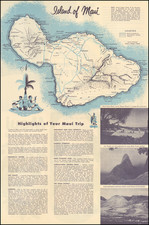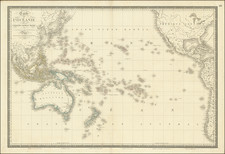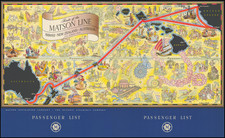Hawaiian Rarity
Rare sea chart of Hawaii, published by Aaron Arrowsmith (and his son Samuel), Hydrographer to the King and the most important English mapmaker of the 19th Century.
The map is compiled from manuscript charts and other material this remarkable large chart of the Hawaiian Islands prominently displays the tracks of Captain James Cook, before and after his death in 1778 and 1779, and George Vancouver’s voyages of 1798.
Mapping Hawaii
The first Britons to publish an encounter with Hawaii were James Cook and his crew on his third voyage. Intended to locate the elusive Northwest Passage, Cook and his men stopped at what he called the Sandwich Islands twice. The second visit cost Cook his life, but his ship and crew sailed home and his edited journal was published in 1784. It included 87 plates showing maps and illustrations. One of these was the first printed map of Hawaii, taken from manuscript sketches by Cook, Lieutenant Henry Roberts, and perhaps William Bligh, a master on the voyage, from 1778 and 1779. Cook's original recorded place names are compared to the revised names given by missionaries in a table below the title.
Other explorers also charted Hawaii, including the Frenchman La Perouse in 1786 and George Dixon and Nathaniel Portlock, veterans of Cook's third voyage, also in 1786. Spurred by the fur trade that was also brought to European attention by Cook, Americans, the Spanish, and Russians soon joined the French and British in frequenting, and charting, Hawaii.
According to Fitzgerald, the honor of the "first complete map" of Hawaii goes to George Vancouver, who served as midshipman on Cook's second and third expeditions (39). Vancouver visited Hawaii several times from 1792 to 1794. The resulting A Chart of the Sandwich Islands is credited to Vancouver's lieutenant, Joseph Baker, but more likely was the result of the measurements and observations of several officers.
By the time Vancouver's voyage had been published, in 1798, the British Admiralty had decided to centralize their chart collection and production and founded the Hydrography Office in 1795. It was put in the hands of Alexander Dalrymple, who was the Royal Society's first choice for the Transit of Venus expedition that was eventually to be commanded by Cook as his first Pacific voyage. All Vancouver's charts passed into the HO's holdings, which explains why the Baker chart was the basis for subsequent Admiralty charts of the Sandwich Islands, including this one.
Baker's influence is clear on this map, but so are contributions by Russian navigators and a Frenchman, Duperry. Louis Isidore Duperrey was a part of the French scientific voyage commanded by Louis de Freycinet (1817-1820). During the voyage, Duperry surveyed the harbors of Honolulu, Kailua, Kawaihae, and Lahaina. His chart of Kailua (Kairua is used on the chart) is included as an inset, which is interesting, since it originally recorded the latitude of the bay wrongly. Here, however, a new latitude for a local landmark have been inserted.
Includes 3 inset charts:
- Hanarura or Fair Haven (Honolulu)
- Village of Raheina (Lahaina)
- Karakakooa Bay (Kealakekua Bay)
Rarity
The map is extremely rare. OCLC shows no institutional examples, however, we located examples in the University of Amsterdam (1826), Royal Geographical Society (1832), and British Library (1840). We also note a privately owned example dated 1830.
The Arrowsmiths were a cartographic dynasty which operated from the late-eighteenth century to the mid-nineteenth. The family business was founded by Aaron Arrowsmith (1750-1823), who was renowned for carefully prepared and meticulously updated maps, globes, and charts. He created many maps that covered multiple sheets and which were massive in total size. His spare yet exacting style was recognized around the world and mapmakers from other countries, especially the young country of the United States, sought his maps and charts as exemplars for their own work.
Aaron Arrowsmith was born in County Durham in 1750. He came to London for work around 1770, where he found employment as a surveyor for the city’s mapmakers. By 1790, he had set up his own shop which specialized in general charts. Arrowsmith had five premises in his career, most of which were located on or near Soho Square, a neighborhood the led him to rub shoulders with the likes of Joseph Banks, the naturalist, and Matthew Flinders, the hydrographer.
Through his business ties and employment at the Hydrographic Office, Arrowsmith made other important relationships with Alexander Dalrymple, the Hudson’s Bay Company, and others entities. In 1810 he became Hydrographer to the Prince of Wales and, in 1820, Hydrographer to the King.
Aaron Arrowsmith died in 1823, whereby the business and title of Hydrographer to the King passed to his sons, Aaron and Samuel, and, later, his nephew, John. Aaron Jr. (1802-1854) was a founder member of the Royal Geographical Society (RGS) and left the family business in 1832; instead, he enrolled at Oxford to study to become a minister. Samuel (1805-1839) joined Aaron as a partner in the business and they traded together until Aaron left for the ministry. Samuel died at age 34 in 1839; his brother presided over his funeral. The remaining stock and copper plates were bought at auction by John Arrowsmith, their cousin.
John (1790-1873) operated his own independent business after his uncle, Aaron Arrowsmith Sr., died. After 1839, John moved into the Soho premises of his uncle and cousins. John enjoyed considerable recognition in the geography and exploration community. Like Aaron Jr., John was a founder member of the RGS and would serve as its unofficial cartographer for 43 years. Several geographical features in Australia and Canada are named after him. He carried the title Hydrographer to Queen Victoria. He died in 1873 and the majority of his stock was eventually bought by Edward Stanford, who co-founded Stanford’s map shop, which is still open in Covent Garden, London today.










![[Aloha - Christmas Post Card]](https://storage.googleapis.com/raremaps/img/small/67516.jpg)
![Mort de Cook [Death of Capt. James Cook]](https://storage.googleapis.com/raremaps/img/small/96645.jpg)
![[Hawaii] Le Isole di Sandwich Delineate Sulle Osservazioni De. Cap. Cook . . . 1798](https://storage.googleapis.com/raremaps/img/small/91731.jpg)

